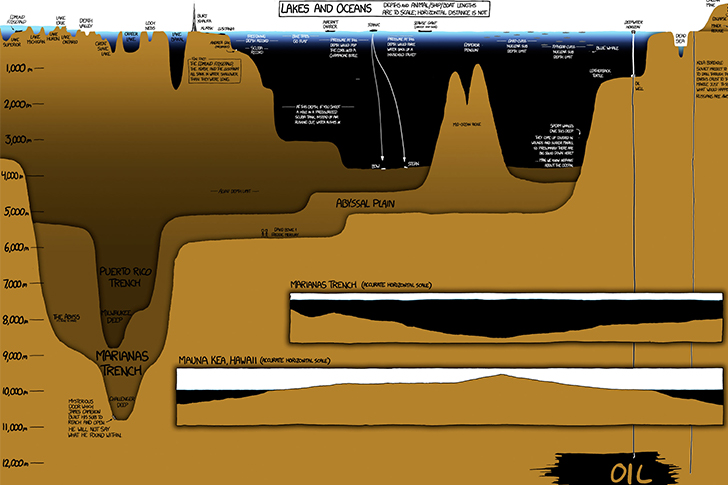This Jaw Dropping Illustration Will Show You How Deep Our Planets Ocean Is
According to the U.S. Geological Survey, almost 71 percent of the Earth’s surface is covered with water, and oceans take up much of that, which is about 96.5 percent. Furthermore, more than 80 percent of the ocean remains unexplored, unobserved, and unmapped, as stated by the National Ocean Service.
Perhaps you’re wondering right now, “How deep, really, the ocean is?”
Let’s take on the illustration of Randall Munroe in his webcomic site xkcd.com for a better understanding in layman’s terms of the ocean’s depth. In his demonstration, it shows comical graphics of the ocean’s drop by meters, using famous landmarks, ships, and buildings to serve as a degree of tangible frame of reference for the uninitiated.

It starts off from the surface at 1,000 meters down to the bottomless abyss of 12,000 meters—at least in the infographics.
Starting from 1,000 meters below sea level, the American ship freighter SS Edmund Fitzgerald sank at about 160 meters deep in North America. On a side note, the deep waters of the ocean have enormous mountain ranges and ridges just like the Earth’s surface above. Anyway, back to our main subject—the depths!
Where was I? Yeah, the sank freighter. The 222-meter SS Edmund Fitzgerald sat on an upland part of Lake Superior— insurance companies are important in situations like this. From there, other groups of lakes are located, including Lake Michigan, Lake Huron, Lake Ontario, and the Great Slave Lake—with their varying deepness, respectively—we’re just starting to scratch the surface here. On the other hand, the deepest freediving record was at 214 meters deep, currently held by Herbert Nitsch. In comparison, the deepest scuba diving record was broken by Egyptian Ahmed Gabr with a depth of 332.25 meters.
Let’s go deeper, shall we? At the time when the Titanic sank, it reportedly split in half—a moving company won’t do here. The bow and the stern of the ship were about 600 meters apart at the bottom of the Atlantic Ocean at a depth of 3,784 meters. In contrast, experts claim that sperm whales dive up to 2,999 meters deep.
With the vastness and deepness of the oceans, various trenches were formed beneath. The Puerto Rico Trench is 497 meters long and has a maximum depth of 8,376 meters. Another is the Milwaukee Trench, a deeper part of the abovementioned trench, with a maximum depth of 8,380 meters, making it the deepest point in the Atlantic Ocean.
Going a degree deeper is the Mariana Trench, where the Challenger Deep is located, where only two people have successfully descended to Earth’s deepest point.
On March 26, 2012, aboard the 7.3-meter deep-diving submersible Deepsea Challenger, James Cameron reached the deepest known point on Earth—the Challenger deep. It has a maximum depth of 10,984 meters found at the bottom of the South Pacific Ocean—how’s that for a deep?
Further beneath beyond the 11,000-meter mark is still unknown and unexplored to man. Certainly, there are various creatures and organisms living down there that have yet been discovered. Somehow, unusually shaped life forms were caught in shallower waters like the frilled shark and anglerfish that live in the 2000-meter-or-less deep part of the ocean.


Perhaps there will come a time in the near future when humanity can plunge deeper into the bottomless abyss of the ocean floor— business loans will surely soar when this happens. With all the technological advancements made and developed, it’s not farfetched to think that this can be a possibility. After all, exploration drives humankind forward, discovering unimaginable things for the first time that bring wonder and astonishment to us all.
Eventually, it will come about. Want to bet on that?
Photo Sources: Pixabay.com, Bored Panda, Instagram, Oceana.org

Recent Comments